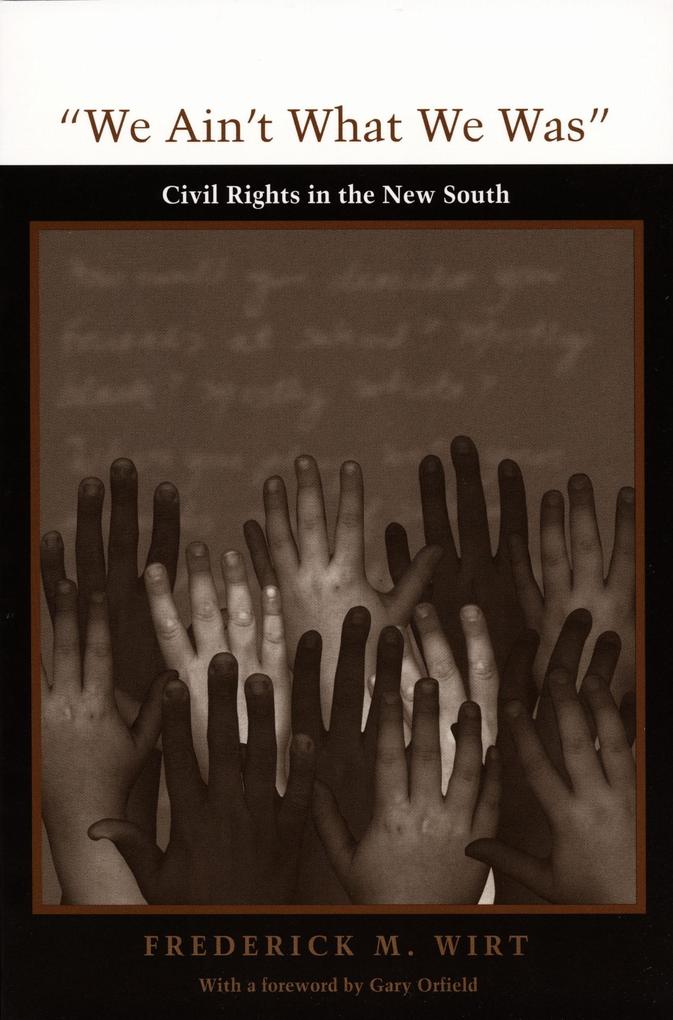
Zustellung: Di, 26.08. - Sa, 30.08.
Versand in 3 Wochen
VersandkostenfreiBestellen & in Filiale abholen:
When officials of the U.S. Department of Justice came in 1961 to Panola County in the Mississippi delta, they found a closed society in which race relations had not altered significantly since Reconstruction. Much has changed, however, in Mississippi in the past three decades, as Frederick Wirt demonstrates in "We Ain’t What We Was," a remarkable look inside the New South. In this follow-up to his highly praised 1970 study of Panola County, The Politics of Southern Equality, Wirt shows how the implementation of civil rights law over the past quarter-century has altered racial reality that in turn altered white perceptions, and thus behavior and attitudes in a section of the country where segregation and prejudice had been most thoroughly entrenched.
Wirt uses multiple indicators-interviews with leaders, attitude tests of children, content analysis of newspapers, school records, and voting and job data-to record what has changed in the Deep South as a result of the 60s revolution in civil rights. Although racism continues to exist in Panola, Wirt maintains that the current generation of southerners is sharply distinguished from its predecessors, and he effectively documents the transformations in individuals and institutions. In a time of increasing popular challenges to the use of law in support of civil liberties, or the place of the federal government to effect necessary social change, this book testifies to the great changes, both public and personal, that were brought about by the strong implementation of civil rights law over thirty years ago. "We Ain’t What We Was" shows that adaptation to change was not overnight, not final, but gradual and always persistent.
Wirt uses multiple indicators-interviews with leaders, attitude tests of children, content analysis of newspapers, school records, and voting and job data-to record what has changed in the Deep South as a result of the 60s revolution in civil rights. Although racism continues to exist in Panola, Wirt maintains that the current generation of southerners is sharply distinguished from its predecessors, and he effectively documents the transformations in individuals and institutions. In a time of increasing popular challenges to the use of law in support of civil liberties, or the place of the federal government to effect necessary social change, this book testifies to the great changes, both public and personal, that were brought about by the strong implementation of civil rights law over thirty years ago. "We Ain’t What We Was" shows that adaptation to change was not overnight, not final, but gradual and always persistent.
Inhaltsverzeichnis
List of Figures and Tables ix
Foreword / Gary Orfield xi
Acknowledgments xv
Part I. The Context for Change 1
1. Setting the Community Scene 4
2. Regional Changes in the South, 1970–1990 16
3. Panola's Pre-1970 Response to Civil Rights 36
Part II. Institutional and Individual Changes in Panola 53
4. Local Politics and Black Empowerment 56
5. South Panola and Desegregation 84
6. Two Responses to Desegregation in North Panola 118
7. The Results for Students in Different Systems 142
8. The Local Economy and Political Regimes 157
Part III. Internal and External Concepts of Race and Law 193
9. Local Perspectives on Race and Law 194
10. The Theoretical Context of Race and Law 216
Appendices
A. Student Sense-of-Self Questionnaire 243
B. Regression Tables of Student Reponses 251
Notes 259
Index 283
Foreword / Gary Orfield xi
Acknowledgments xv
Part I. The Context for Change 1
1. Setting the Community Scene 4
2. Regional Changes in the South, 1970–1990 16
3. Panola's Pre-1970 Response to Civil Rights 36
Part II. Institutional and Individual Changes in Panola 53
4. Local Politics and Black Empowerment 56
5. South Panola and Desegregation 84
6. Two Responses to Desegregation in North Panola 118
7. The Results for Students in Different Systems 142
8. The Local Economy and Political Regimes 157
Part III. Internal and External Concepts of Race and Law 193
9. Local Perspectives on Race and Law 194
10. The Theoretical Context of Race and Law 216
Appendices
A. Student Sense-of-Self Questionnaire 243
B. Regression Tables of Student Reponses 251
Notes 259
Index 283
Produktdetails
Erscheinungsdatum
18. Februar 1997
Sprache
englisch
Untertitel
Civil Rights in the New South.
Sprache: Englisch.
Seitenanzahl
312
Autor/Autorin
Frederick M Wirt
Verlag/Hersteller
Produktart
gebunden
Gewicht
730 g
Größe (L/B/H)
244/164/29 mm
ISBN
9780822319016
Pressestimmen
"This book is a very important treatment of one of the greatest accomplishments of the American political and legal system - the elimination of the system of state-imposed apartheid in the South... [It] offers richly grounded observations by the same scholar of the same issues over a quarter century of profound and complex change and provides an important resource for historians and those trying to think about the capacity of law to resolve aspects of the American racial crisis." - Gary Orfield, from the foreword "For years, Fred Wirt has been a sane, sensible, deeply insightful analyst of some of our nation's most complicated and controversial issues - those dealing with race, class, legal compulsion, and cultural change. He takes on all of those issues here in a book as wise as it is illuminating. It shows us to ourselves in a way that we can immediately comprehend but that suggests new possibilities and grander visions. This is simply a wonderful book." - Jennifer Hochschild, Princeton University
Bewertungen
0 Bewertungen
Es wurden noch keine Bewertungen abgegeben. Schreiben Sie die erste Bewertung zu "We Ain't What We Was" und helfen Sie damit anderen bei der Kaufentscheidung.










